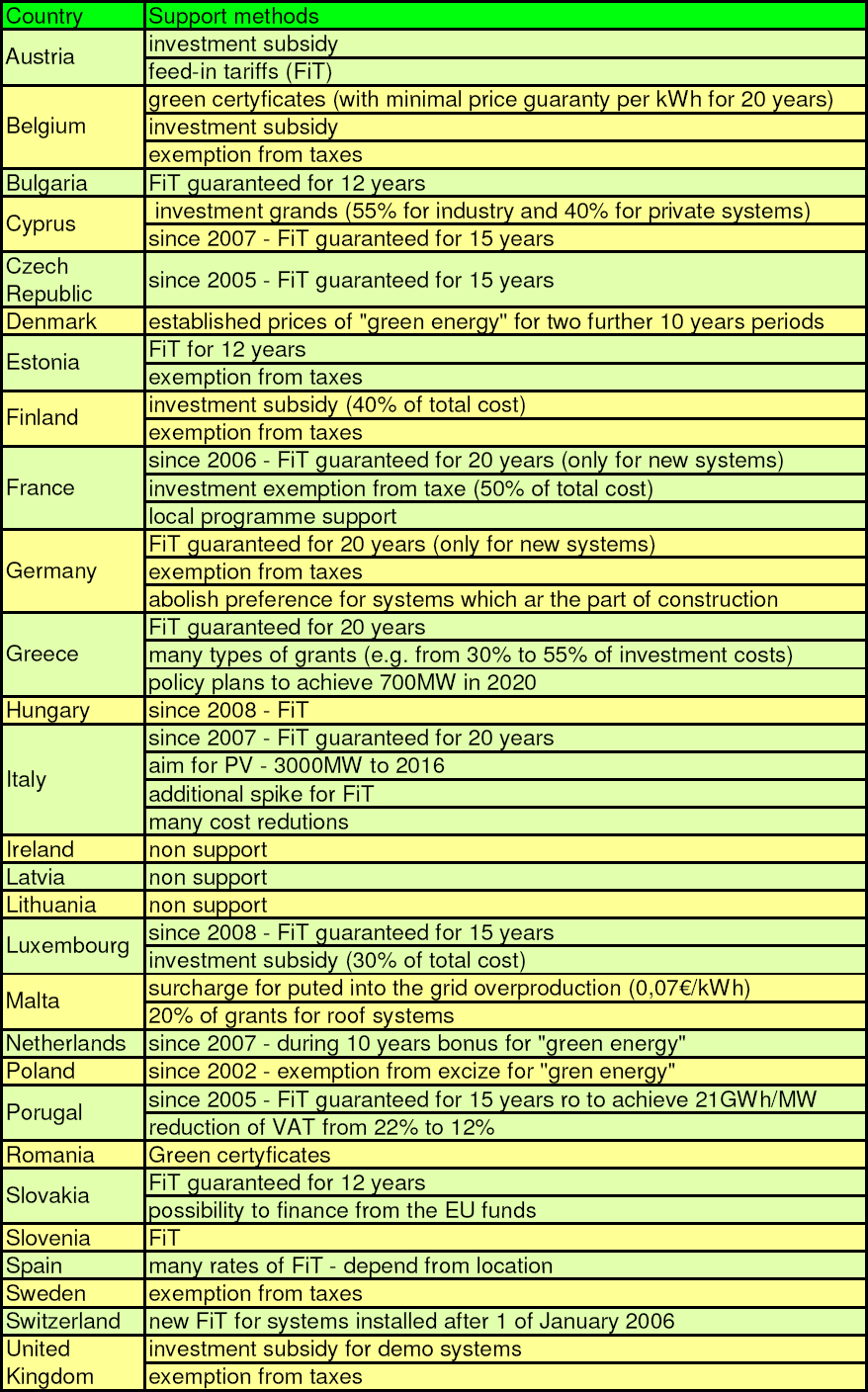
Economic aspects of solar power
Although the solar technologies are very different each other unfortunately all of them are quite expansive. Therefore the governments of many countries runs the support programme for higher develop and commercialisation of solar technology. As the RES technology, solar project are also supported by 6 instruments of support for renewable technologies in the EU countries. That instruments it is: feed-in tariff system, feed-in premium system, renewable or quota obligations, tax incentives or exemptions, fiscal incentives, investment grants. All of the EU countries obligate to establish minimum one of mentioned instrument. In each country is different level of support however it provides to the RES technology development. [43]
PV system
The most expansive of them used to be PV technology, but at present the investment costs has considerably decreased and it becoming also common and competitive to the other. A lot of government supports has provided to rapid develop that technology in the USA, Japan and in many countries of the UE, particularly: Spain, Germany and Italy. At present the investment cost of small PV installation (from 3 to 20kW) is about €5 per watt and for large power plant (more than 1MW) between €3 to €4 per watt. That costs are still goes down however slower than in the past. The average cost of energy produced equals € 30 per kW*year. That value fluctuates between from € 20 to € 45 per kW*year and depends from latitude. But the EU strategy presupposes the drop of that cost to the value between € 5,5 to € 26 per kW*year. In 2008 on the world has been installed 5,56GW of PV systems. That gives more than 13GW of PV systems in the world (mainly in Spain and German – about 75%). The planed average annual growth of PV systems equals 22%. Most of systems are installed in grid-connected configuration and most of modules are made in crystalline silicon technology but the rate of thin film modules growths rapidly e.g. in 2008 more than 50% of PV module production in USA was made in the thin film technology. [9], [11] The major disadvantage of the PV technology is relative high cost of electricity, techno-economic issues, lack of skilled professionals, grid connection. Moreover the annual amount of hour production is relatively low, e.g. in Cracow it is about 1600 hours. However at present the PV technology is in a pick-up stage and the feed-in support in the most of the UE countries, in the USA may provide to make the PV system more competitive in the relation to the other technologies. The following figure shows the method and types of financial support for development of the PV technologies. (Fig. 29) [25], [26]

The average lifetime of PV power plant is about 25 years. [43]
CSP system
The most expansive of them used to be PV technology, but at present the investment costs has considerably decreased and it becoming also common and competitive to the other. A lot of government supports has provided to rapid develop that technology in the USA, Japan and in many countries of the UE, particularly: Spain, Germany and Italy. At present the investment cost of small PV installation (from 3 to 20kW) is about €5 per watt and for large power plant (more than 1MW) between €3 to €4 per watt. That costs are still goes down however slower than in the past. The average cost of energy produced equals € 30 per kW*year. That value fluctuates between from € 20 to € 45 per kW*year and depends from latitude. But the EU strategy presupposes the drop of that cost to the value between € 5,5 to € 26 per kW*year. In 2008 on the world has been installed 5,56GW of PV systems. That gives more than 13GW of PV systems in the world (mainly in Spain and German – about 75%). The planed average annual growth of PV systems equals 22%. Most of systems are installed in grid-connected configuration and most of modules are made in crystalline silicon technology but the rate of thin film modules growths rapidly e.g. in 2008 more than 50% of PV module production in USA was made in the thin film technology. [9], [11], [43] The major disadvantages of the CSP power plant are: high cost of electricity, lack of feed-in support (excluding Spain), investment in grid infrastructure. However the CSP is relatively new technology and may develop if the few of the needs would be achieved e.g.: expansion of feed-in tariffs or commercialisation projects.[9], [11]
-
Description of technology|
Economic aspects|
Environment and public awareness|
Legislation|
Final comparison|
References

